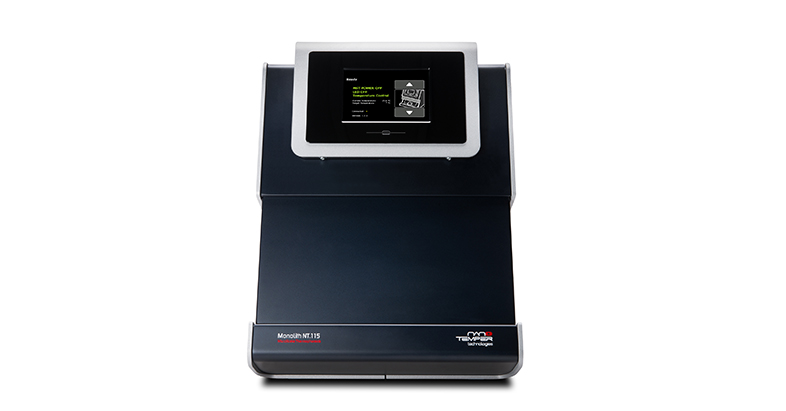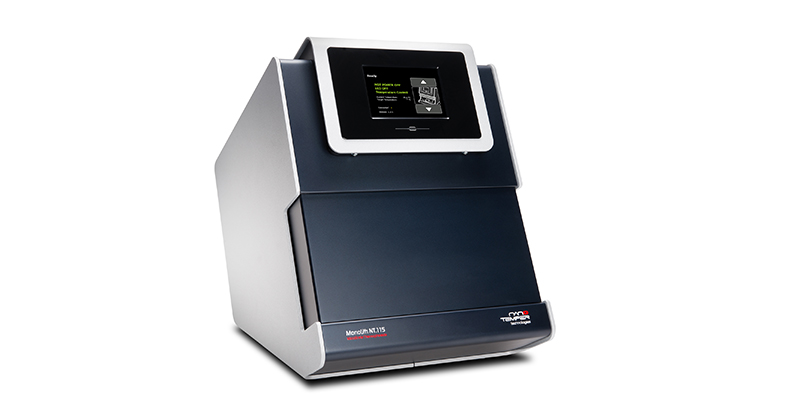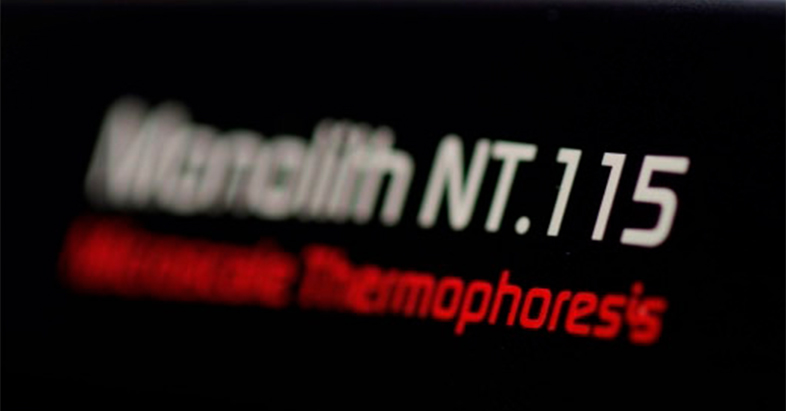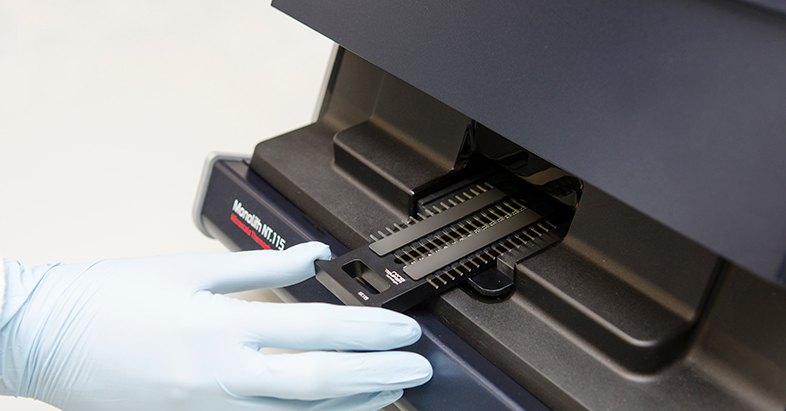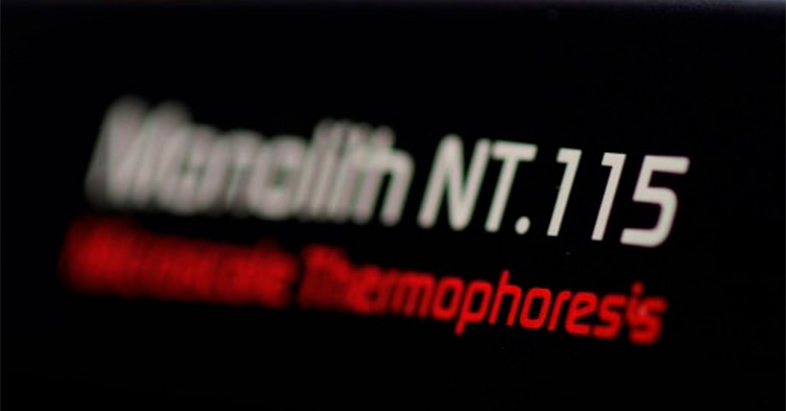Monolith NT.115 系列仪器用于各种生物分子的相互作用测试,应用范围从离子到纳米颗粒。

Monolith NT.115 系列仪器秉承着微量热泳动技术的所有优点,并支持各种荧光标签和荧光融合蛋白的多样化使用。每台仪器配备的 Nano 检测器都有两个不同荧光通 道。可选择的通道组合有:
无论是巨大的蛋白复合体的形成还是单一金属离子间的结合,Monolith NT.115 可测量各种类型的相互作用。不受缓冲液成分的限制,即使复杂体系,如血清或者细胞裂解液,也可以用来测试。
主要特点
1. 检测范围:解离常数nM – mM (如低于纳摩级别,适用NT.115pico)
2. 多种市面常见荧光染料和荧光融合蛋白均适用
3. 样品消耗低:每个滴定点只需4 µl
4. 仅需10 nM 荧光分子
5. 免纯化,可在细胞裂解液或血清中进行
6. 分子大小无限制:小到低分子量分子间,大到核糖体间的相互作用均可检测
7. 数分钟内获得Kd值
8. Kd-plus:获得Kd值同时附加样品性质和聚集情况信息
9. 免维护
10. 操作方便:样品准备简单,软件界面友好直观
肿瘤药物学

"We can strongly recommend the MST technology for its low material consumption, short measurement times and broad application range"

"Our recent research is focused on the molecular basis of herbicide resistance and exploiting new target sites of herbicide, such as PPI of AHAS. Via MST, we measured the Protein-Protein interaction, that have been difficult to detect and quantify with ITC because of instability of the protein and very little heat changes of our samples. The MST technology can be used as a complementary technology to the traditional methods in these fields. We can strongly recommend the MST technology for its low material consumption, short measurement times and broad application range in the field of molecule interaction studies."
Prof. Zhen Xi, Chairman, Dean of Academic Affairs, School of Chemistry
Fellow of the University Committee
"Via MST, we measured interactions, that have been difficult to detect and quantify with other interaction technologies"

Past positions: Vice Director of the Institute of Biophysics; Director of the Center for the Molecular Biology, Institute of Biophysics; Vice Chairman of the Crystallographic Society of China; Vice Chairman of the Biophysical Society of China
"Our recent research is focused on the critical pathogenic protein & complex from pathogenic microbes and the Protein structure-functional basis for some endogenous disease. Via MST, we measured the Protein-DNA interaction, that have been difficult to detect and quantify with other standard biomolecule interaction technologies (like SPR and ITC) because of the conformation/immobilization-sensitive and very little heat changes of our samples. MST technology can be used as a complementary technology to the traditional methods in these fields. We can strongly recommend MST technology for its low material consumption, short measurement times and broad application range for molecule-interaction studies."
Prof. Dacheng Wang, MCAS, Member of Chinese Academy of Sciences
"MST technology turns out to be an excellent way to determine such weak interactions between small fragments and protein"

"We are interested in applying computational fragment-based strategy to identify lead compounds to block protein-protein interactions in RAS pathway. Generally, the identified fragments are weak binders with binding affinities ranging from millimolar to micromolar. For such weak interactions, it is difficult to set up reliable biochemical assays or binding assays using ITC or SPR techniques. Fortunately, MST technology turns out to be an excellent way to determine such weak interactions between small fragments and protein in our system of interest. We efficiently and reliably performed our experimental binding measurement using minimum amount of protein and fragments.
We are also interested in studying the regulation mechanism of a nuclear hormone receptor, which plays fundamental role in homeostasis and metabolism. The nuclear hormone receptor can be modified by an important enzyme to regulate the expression of specific genes and cause certain metabolic disease. We wanted to measure the binding affinity between these two proteins. Interestingly, this interaction is extremely difficult for the standard binding affinity measurement approach, with no exothermal or endothermal signals using ITC. While using MST technology, we have successfully detected this interaction. We strongly recommend MST technology for its low material consumption, short measurement time, and very high sensitivity."
Niu Huang, Ph.D.;
Associate Investigator, NIBS, Beijing, China
"We strongly recommend MST technology for its low material consumption, short measurement time and very wide application range."

"Part of our research focus on the protein structural-function basis for iron metabolism of pathogenic microorganisms. We measured the dissociated constant for periplasmic binding protein and siderophore through MST technology. Because siderophore is extremely insoluble, it's difficult for us to complete that task via other methods such as ITC and SPR. We strongly recommend MST technology for its low material consumption, short measurement time and very wide application range."
Prof. Li-chuan GU, Principal Investigator, Shandong University, China

Our lab focuses on the importance for telomere and telomerase to maintain the integrity of genomes and the stability of chromosomes. Large amount of proteins and protein complexes are involved in epigenetics, which play essential rotes in controlling many cellular events. We are employing MicroScale Thermophoresis (MST) in determining the interactions of proteins/protein complexes to ssDNA/RNA. It's easier to measure the protein-protein or protein-nucleic acid interaction, especially for those sensitive samples, that has been difficult to detect and quantify with ITC or SPR. We benefited from the low sarnple consumption, the fast measurements, the broad application range and the possibility to choose the buffer freely, resulting in highly reproducible data. We strongly recommend MST technology for its low material consumption, short measurement times and very high sensitivity.


MST是一个具有高度灵活性和功能强大的研究工具。由于它具有较好的鲁棒性,对溶液成分、待测分子和样品数量要求不高,特别适合对难以检测的分子间相互作用进行研究。对于整合在脂质双分子层里的全长膜蛋白与其它物质相互作用进行分析时,几乎是当前最直接、最适用的方法。
本实验室主攻细菌受体组氨酸激酶的分子识别机制,必须利用蛋白脂质体、Nanodisc等膜蛋白技术进行分析。基于MST技术,我们已经做出了多项细菌感知寄主与环境刺激的重要科学发现,成果发表在包括Cell Reports, PLoS Pathogens和MolPlant-Microbe Interact在内的期刊上。周边实验室利用该设备开展了配体-受体互作、蛋白-DNA互作等实验也获得了理想的结果,成果发表在Nature, Nat Genet等高影响力期刊上。因此,MST是开展分子间相互作用研究的强大工具之一。



"We are very pleased with the low material consumption, short measurement times and broad application range of MST."

In my group we explore the structural, biophysical, and cellular outcomes of protein complex formation at membrane-bound receptors. We use Microscale Thermophoresis (MST) in addition to other methods including isothermal titration calorimetry and surface plasmon resonance and find a good agreement between the methods. We are very pleased with the low material consumption, short measurement times and broad application range of MST.
Prof. John E. Ladbury - Department of Biochemistry and Molecular Biology The University of Texas M. D. Anderson Cancer Center, Houston, TX, USA
"MST is straightforward and fits well in our technology portfolio"

"We are interested in the biophysical properties of soluble and membrane bound biomolecules and are using MST to measure binding affinities and complex formation. MST is straightforward and fits well in our technology portfolio to cover a broad spectrum of synthetic biomolecules including proteins, peptides and nucleic acids"
Prof. Dr. Ulf Diederichsen, Institute for Organic and Biomolecular Chemistry, Georg-August-Universität Göttingen, Germany
肿瘤药物学

"Using this technology we obtained very convincing data that were in agreement with results obtained using other technologies"

"Our research is based on the development of small molecular compound based on or derived from linear peptides that have successfully been tested in animal models for inhibition of tumour angiogenesis and/or metastasis. These compounds are promising candidates to enter in clinical studies in the near future. We recently used NanoTemper Technologies' Microscale Thermophoresis to characterize the affinity of our compounds to their targets. Using this technology we obtained very convincing data that were in agreement with results obtained using other technologies like Surface Plasmon Resonance (SPR). We appreciated the relatively short time for the time to establish the assay compared to alternative methods to measure protein affinities as well as the comparatively low amounts of protein consumption. We conclude that this new technology gives rise to reliable quantitative affinity data."
Dr. Alexandra Matzke, CSO, amcure GmbH, Germany
"We cannot think of any technique other than MST that would allow studying this cooperative binding to such detail"

"Our work focuses on the structure and function of proteins involved in signal transmission in the synaptic cleft. Upon arrival of an action potential in the synapse, ion channels open resulting in an increase in cytoplasmic calcium. This increase in calcium concentration is sensed by synaptotagmin-1 which mediates exocytosis of synaptic vesicles and release of neurotransmitter in the synaptic cleft. The precise mechanism of action of synaptotagmin-1 is unknown, but involves both binding to calcium and to the phospholipid PIP2 in the plasma membrane. In our MST studies, we used the technology to precisely quantify the cooperativity of PIP2 and calcium binding. PIP2-binding to synaptotagmin-1 resulted in a 40-fold higher affinity for calcium, and this result is of fundamental importance for our understanding of neuronal exocytosis. Given (i) the relatively high affinity of synaptotagmin-1 for both PIP2 and calcium, (ii) the low solubility of PIP2 and (iii) that synaptotagmin-1 is prone to aggregate at high protein concentrations, we cannot think of any technique other than MST that would allow studying this cooperative binding to such detail. Moreover, due to the very high sensitivity of MST, we estimate that the same amount of synaptotagmin-1 suffices to record about 10,000 times more calcium binding curves with MST compared to NMR or ITC."
Dr. Geert van den Bogaart, Max Planck Institute for Biophysical Chemistry, Department of Neurobiology, Göttingen, Germany
"Using MST, we determined the binding affinities of a wild-type protein and 11 mutants in a half day"

"We develop new high throughput molecular biology methods and use them to study enzymes of biological and medical interest. For example, we are testing permutations of influenza-influenza and influenza-host proteins, with the aim of defining expressible, crystallisable protein complexes that should provide insights into virus-host cell interactions. In this context, MicroScale Thermophoresis (MST) is an extremely valuable tool to assess and quantify interactions. In one study using MST, we determined the binding affinities of a wild-type protein and 11 mutants in a half day; this would have been impossible with other techniques.
We are using the Monolith NT.115 in our daily research work and we are very satisfied by the data obtained with this novel biophysical method. In addition, we appreciate the support and the competence from the NanoTemper Technologies Company."
D. J. Hart, PhD; Team Leader at the European Molecular Biology Laboratory (EMBL). Grenoble, France
"MST has proven an ideal way for cell biologists in our institute to quantify interactions"

"One major focus of research in our institute is the dynamic organization of the microtubule cytoskeleton. An important approach for understanding the molecular mechanisms underlying tubulin assembly and microtubule motility has been the establishment of in vitro biochemical assays using purified components. Often, fluorescent microscopy, employing tagged or labeled microtubule associated proteins (MAPs) and motors, is used to study tubulin assembly and microtubule based motility.
We use Microscale Thermophoresis (MST) to investigate and quantify the interactions of these motors and MAPs with both un-assembled tubulin subunits as well as polymerized microtubules.
Previously, we have employed size exclusion chromatography, sucrose gradient sedimentation and immuno-precipitation to detect but not quantify these interactions as the necessary instrumentation was unavailable. MST has proven an ideal way for cell biologists in our institute to quantify interactions as, in most cases, the fluorescently tagged protein preparation is already available and, most importantly, only a limited amount of sample is required.
A second research focus in our institute is the assembly and dynamics of cell membranes, in particular, endosomes. We have started using MST to quality control the loading and exchange of guanine nucleotides on Rab5 protein, a small GTPase and a key regulator of endosome assembly. In this case, MST is used to monitor the nucleotide dependent association of Rab5 with proteo-lipid vesicles."
Dr. David Drechsel, Group Leader and Service and Facility Leader at the Max-Planck-Institute of Molecular Cell Biology and Genetics, Dresden, Germany
"We appreciate that the interactions are investigated free in solution"

"The MicroScale Thermophoresis (MST) technology is a good complement to other biophysical techniques we are applying in the lab to investigate receptor proteins involved in inflammatory response. However, MST provides additional benefits since we are interested in elucidating interactions in close-to-native conditions: thus, we appreciate that the interactions are investigated free in solution and can be studied even in cell lysate. We are using MST for a number of different interactions, mainly to investigate protein-protein interactions but also to study protein-DNA interactions and protein binding to ions.
MST is a novel technique which is not related to any other established biophysical methods thus providing independent insights into biomolecular interactions. It is very easy to use with low time and material consumption."
Prof. Dr. med. Uffe Holmskov;
Head of the Institute for Molecular Medicine, University of Southern Denmark, Odense, Denmark
"We can strongly recommend the MST technology for its low material consumption, short measurement times and broad application range"

"Our recent research is focused on the molecular basis of herbicide resistance and exploiting new target sites of herbicide, such as PPI of AHAS. Via MST, we measured the Protein-Protein interaction, that have been difficult to detect and quantify with ITC because of instability of the protein and very little heat changes of our samples. The MST technology can be used as a complementary technology to the traditional methods in these fields. We can strongly recommend the MST technology for its low material consumption, short measurement times and broad application range in the field of molecule interaction studies."
Prof. Zhen Xi, Chairman, Dean of Academic Affairs, School of Chemistry
Fellow of the University Committee
"The speed of the assay and low sample consumption has allowed us to quickly identify the critical residues"

"Our recent research has focussed on the interactions of proteins involved in the Hedgehog signalling pathway. We have used MST to develop a binding assay with fluorescently labelled peptide and unlabelled protein. The speed of the assay and low sample consumption has allowed us to quickly identify the critical residues in the binding site by rapidly screening a series of mutated proteins. Furthermore, the assay can easily be adapted to screen peptides and small molecules for competitive binding."
Luca Jovine, Ph.D.;
Professor of Structural Biology & EMBO Young Investigator, Karolinska Institutet, Huddinge, Sweden;
Amy Cherry, PhD;
Lecturer in Biochemistry at University of Worcester, UK
"Via MST, we measured interactions, that have been difficult to detect and quantify with other interaction technologies"

Past positions: Vice Director of the Institute of Biophysics; Director of the Center for the Molecular Biology, Institute of Biophysics; Vice Chairman of the Crystallographic Society of China; Vice Chairman of the Biophysical Society of China
"Our recent research is focused on the critical pathogenic protein & complex from pathogenic microbes and the Protein structure-functional basis for some endogenous disease. Via MST, we measured the Protein-DNA interaction, that have been difficult to detect and quantify with other standard biomolecule interaction technologies (like SPR and ITC) because of the conformation/immobilization-sensitive and very little heat changes of our samples. MST technology can be used as a complementary technology to the traditional methods in these fields. We can strongly recommend MST technology for its low material consumption, short measurement times and broad application range for molecule-interaction studies."
Prof. Dacheng Wang, MCAS, Member of Chinese Academy of Sciences
"MST technology turns out to be an excellent way to determine such weak interactions between small fragments and protein"

"We are interested in applying computational fragment-based strategy to identify lead compounds to block protein-protein interactions in RAS pathway. Generally, the identified fragments are weak binders with binding affinities ranging from millimolar to micromolar. For such weak interactions, it is difficult to set up reliable biochemical assays or binding assays using ITC or SPR techniques. Fortunately, MST technology turns out to be an excellent way to determine such weak interactions between small fragments and protein in our system of interest. We efficiently and reliably performed our experimental binding measurement using minimum amount of protein and fragments.
We are also interested in studying the regulation mechanism of a nuclear hormone receptor, which plays fundamental role in homeostasis and metabolism. The nuclear hormone receptor can be modified by an important enzyme to regulate the expression of specific genes and cause certain metabolic disease. We wanted to measure the binding affinity between these two proteins. Interestingly, this interaction is extremely difficult for the standard binding affinity measurement approach, with no exothermal or endothermal signals using ITC. While using MST technology, we have successfully detected this interaction. We strongly recommend MST technology for its low material consumption, short measurement time, and very high sensitivity."
Niu Huang, Ph.D.;
Associate Investigator, NIBS, Beijing, China
"This method is particularly useful to perform low affinity binding measurements using low amounts of proteins."

My group focuses on the molecular mechanisms of action of Receptor Tyrosine Kinases (RTKs) and Cell Adhesion Molecules (CAMs) in development and tumor progression. We have shown that the activation of RTKs relies not only on the binding of the ligand but also on the collaboration with CAMs such as CD44. We measured the binding of several growth factors to CD44 using the NanoTemper Technologies' Microscale Thermophoresis. Using this technology we obtained very convincing data that were in agreement with results obtained using other technologies like Surface Plasmon Resonance (SPR). This method is particularly useful to perform low affinity binding measurements using low amounts of proteins. We are extremely satisfied with the quantitative data obtained with this new technology.
PD Dr. Orian-Rousseau, Group Leader Institute for Toxicology and Genetic, Karlsruher Institut für Technologie (KIT)
"We are using the Monolith NT.115 in our daily research work and we are very satisfied by the data obtained"

"We use an integrative structural biology approach to study the regulation of gene expression by nuclear receptors. In this context, Microscale Thermophoresis (MST) is an extremely valuable tool to assess and quantify ligand-receptor, cofactor-receptor and nucleic acid-receptor interactions. By using MST, we determined the binding affinities of wild-type and mutant coregulator constructs for a homodimeric nuclear receptor that were in very nice agreement with those measured with isothermal titration calorimetry (ITC). However, in addition to ITC, MST allowed us to examine a range of concentration ratios between the two binding partners that could not be reached with ITC and to demonstrate the existence of allosteric control in the binding of the coregulator to the homodimeric nuclear receptor. We are using the Monolith NT.115 in our daily research work and we are very satisfied by the data obtained with this novel biophysical method. In addition, we appreciate the support and the competence from the NanoTemper Technologies Company."
Dr. Isabelle M.L. Billas, Team ‘Large complexes involved in gene expression’ led by Dr. Bruno Klaholz - Department of Integrative Structural Biology, France
"It has proved a valuable tool for characterising small molecule-protein and protein-protein interactions"

"We routinely assess interaction affinity for both small molecule and biologics projects, with NanoTemper Technologies' Microscale Thermophoresis being the most recent addition to the pool of instruments we use to carry out these measurements. It has proved a valuable tool for characterising small molecule-protein and protein-protein interactions, as well as for the study of protein aggregation concentration determination. There is very good agreement with other technologies such as Surface Plasmon Resonance (SPR) and Isothermal Titration Calorimetry (ITC), and we are particularly appreciative of this new technology because of the extremely low protein consumption and relatively short time required for the assay setup. NanoTemper customer support has been a key factor in enabling us to familiarise ourselves with the new technology. We would like to deploy increasing numbers of applications based on MST technologies and continue to interact with NanoTemper Technologies Company, a dynamic, scientifically driven company."
Dr. Alexey Rak,
Head of Structural Biology & Biophysics, Sanofi R&D, France
"LabelFree MST is one of the few true label-free/immobilisation-free instruments capable of measuring molecular interactions"

"As part of our drug discovery projects we use Microscale Thermophoresis (MST) as an orthogonal method to measure the binding affinity of compounds to their protein target and apply this fragment hit ID through to lead optimisation. MST complements our biophysical platform and has correlated well with other more established technologies. Because it uses small amounts of protein, MST has proved to be particularly useful to look at molecular interaction involving proteins that are difficult to express or purify. MST requires a relatively short time to setup new assays and is a powerful technique for buffer optimisation. Using the NT.115 MST instrument we have successfully measured small molecule-protein and protein-protein interactions in complex media. Finally, LabelFree MST is one of the few true label-free/immobilisation-free instruments capable of measuring molecular interactions. We have appreciated the professionalism and support from NanoTemper Technologies."
Dr. Nicolas Basse, Department of Structural Biology, UCB-Celltech, UK
"It allows us much better analysis of the GPCR with their small-molecule ligands."

"We are interested in molecular architectures especially to stabilize and analyze challenging smell receptors that belong to G protein-coupled receptors (GPCRs). GPCR is a super-family of receptors linked to many diseases. We want to measure the interactions of smell receptors with odorant that are very low molecular weight ligands. In the past that has been extremely difficult to detect and quantify other common molecular interaction technologies including SPR, and nearly impossible to use ITC for odorant-binding measurement because of the conformation and immobilization-sensitivities, or difficult and costly to obtain sufficient amount of receptors. The MST technology is a superb technology, it not only is label-free, hence reducing the measuring artifacts, but it also is surface-free that provides true measurement of finest molecular interactions. Thus it allows us much better analysis of the GPCR with their small-molecule ligands. We strongly recommend MST technology for its low material consumption (a few micrograms in a few microliters), short measurement times, inexpensive consumables, and broad application range in all molecule-interaction study."
Dr. Shuguang Zhang, Center for Bits and Atoms
"this fast and easy to use method provides a highly welcome alternative to the radioactive enzyme assay"

“The main focus of our work lies on structure based-drug design. In this context, we study the interaction of the bacterial tRNA modifying enzyme tRNA-guaninetransglycosylase (Tgt) with small molecule inhibitors and with tRNA. Althoughwe were unable to measure any interaction of this enzyme with its small moleculesubstrates guanine and 7-deaza-7-aminomethyl guanine via MST, a strong influence on the thermophoretic behaviour of Tgt was noticed upon binding of the Macromolecular tRNA substrate allowing determination of the respective Kd value. In addition, MST yielded Kd values for lin-benzoguanine-based Tgt inhibitors (300-500 Da), which were excellently consistent with Ki values previously determined in enzyme kinetic studies. Accordingly, this fast and easy to use method provides a highly welcome alternative to the radioactive enzyme assay we used so far to figure out binding affinities of Tgt inhibitors. Furthermore, we investigate the interaction of a chaperone of the Shigella type III secretion system with its protein interaction partners or rather with synthetic peptides thereof to identify the respective recognition motifs. Via MST, we determined with low amounts of protein material Kd values which were in nearly perfect agreement with those measured via isothermal titration calorimetry.”
Prof. Dr. Gerhard Klebe,
Institut für Pharmazeutische Chemie, Philipps-Universität Marburg, Germany
"Access to accurate information on fragment Kd, binding mode and aggregation behaviour of compounds enable informed decision making."

"Together with Nanotemper Technologies we have optimized microscale thermophoresis for fragment screening applications which are difficult to access with standard technologies. Access to accurate information on fragment Kd, binding mode and aggregation behaviour of compounds enable informed decision making. Together with a proprietary fragment collection, this technology forms now the core of the CRELUX fragment based drug discovery service offerings. "
Dr. Ismail Moarefi, Chief Scientific Officer of CRELUX GmbH - A WuXi AppTec Company in Martinsried, Germany
"MST is a versatile and valuable tool which we quickly adapted in our repertoire of methods."

"One mission of the Structural Research group within the Lead Identification and Optimization department is to quantitatively validate and characterize interactions of small molecules as well as new biological entities with protein targets. We employ various traditional biophysical methods such as SPR, Thermal Shift, ITC, NMR and X-ray crystallography.
Most recently we included Microscale Thermophoresis (MST) in our standard project support workflow and extended its application from affinity determinations to fragment screening approaches. MST is a versatile and valuable tool which we quickly adapted in our repertoire of methods. The impressive advantages of MST, namely the low sample consumption, the broad application range, and swift assay development make it a unique biophysical method. The measurement in free solution without the need of surface coupling saves time and avoids a potential source for false positive or negative results.
Our Structural Research group now also added the label-free version of the Monolith to our MST instrumentation portfolio, which gives us the possibility to choose to measure with high selectivity and sensitivity (NT.115). The labelfree version (NT.LabelFree) allows us to measusre without any additional sample modification depending on the need of the particular assay. In some cases, LabelFree MST allowed us to perform assays with otherwise "very ill" behaved proteins which were not amenable to any other biophysical technique. Generally, we find very good consistency between quantitative MST measurements and results stemming from other biophysical methods."
Dr. Markus Zeeb, Principal Scientist, Structural Research, Boehringer-Ingelheim, Germany
"We can definitely recommend MST for obtaining robust quantitative affinity data"

"The work of our group gave rise to the novel concept that under certain conditions matrix components may act as endogenous "danger" signals, which are recognized by innate immunity receptors, and are capable to trigger an inflammatory response reaction. We are using MST to measure the interactions of endogenous and in vitro mutagenized proteoglycans of the extracellular matrix with their receptors and are very satisfied with the results obtained so far. The affinities are consistent with the biological readouts and confirm previous results gained with immunprecipitation and binding assays. MST is a new technology we can definitely recommend for obtaining robust quantitative affinity data."
Prof. Dr. med. Liliana Schaefer, Pharmazentrum /ZAFES, Frankfurt a.M., Germany
"With the MST technology we were able to measure the interaction of membrane vesicles"

"Membrane interaction and fusion plays a fundamental role in many cellular processes such as intracellular trafficking, fertilization, tissue formation or viral infection. With the new MST technology we were able to measure the interaction of membrane vesicles, mediated by coiled coil-forming peptides. The technology requires only little sample material and is enabling for this type of experiments"
Prof. Dr. Andreas Janshoff, Dept. of Physical Chemistry. University of Göttingen, Germany
"It enables us to ask questions that we could not address before"

"We are studying the processing of microRNA precursors In Drosophila and are using MST to measure the binding of nucleolytic Enzymes and their specificity factors to RNA substrates. The small amount of protein sample needed and the much faster measuring time compared with e.g. gel-shift assays are particular strengths of this new technique. It enables us to ask questions that we could not address before."
Prof. Dr. Klaus Förstemann, Gene Center of the LMU, Munich, Germany
"MST provides us with a unique tool to validate lead inhibitors"

Yi Zheng, PhD, Director, Division of Experimental Hematology and Cancer Biology; Katherine Stewart Waters Endowed Chair, University of Cincinnati College of Medicine, USA
"We strongly recommend MST technology for its low material consumption, short measurement time and very wide application range."

"Part of our research focus on the protein structural-function basis for iron metabolism of pathogenic microorganisms. We measured the dissociated constant for periplasmic binding protein and siderophore through MST technology. Because siderophore is extremely insoluble, it's difficult for us to complete that task via other methods such as ITC and SPR. We strongly recommend MST technology for its low material consumption, short measurement time and very wide application range."
Prof. Li-chuan GU, Principal Investigator, Shandong University, China
"MST is very useful for my lab since it allows to measure interactions in solution"

"We are interested in understanding the interactions between cells and organisms by investigating the role of polysaccharides exposed on cell surfaces and secreted polysaccharide signal molecules. We are applying MST to determine structural requirements for recognition of complex polysaccharides and the role of ligand-receptor interactions in the relationships between different cells and organisms.
MST is very useful for my lab since it allows to measure interactions in solution even in complex samples of membrane proteins. Also the small amount of sample material needed and the broad range of applications are very advantageous."
Prof. Jens Stougaard, Director of CARB, Department of Molecular BiologyLaboratory of Gene Expression, Aarhus University, Denmark
"MST is simple to use and was quickly established in our lab."

"Our lab is developing diagnostic tools based on protein biochips and is studying the basic mechanisms underlying herpes virus infections" We are using MST for elucidating the function of viral proteins and its interaction with other viral and host cell proteins. MST is simple to use and was quickly established in our lab. In particular we do appreciate the low instrument, consumables and maintenance costs associated with this new technology"
Dr. Maria G. Vizoso Pinto, Max-von-Pettenkofer Institute, Munich, Germany
"The MST technology is easy to use and a good alternative to our standard enzymatic assays"

We are interested in the basic mechanisms in epigenetics which define and maintain the histone code and are using MST to measure the binding of “reader”-proteins to modified histone peptides as well as the activity and inhibition of “writer” enzymes including kinases, demethylases and methylases.
The new MST technology is easy to use and a good alternative to our standard enzymatic assays which are radioactive and measure endpoints only. It allows us to easily measure affinities for protein-peptide interactions in solution”
Prof. Dr. Axel Imhof, Head of the Chromatin Modification Group, Adolf Butenand Institute, LMU, Munich, Germany
"MST really is opening up the easy determination of some Kd's that were hard to get to with other methods"

“We study the structural and molecular biology of bacterial adhesins and cell-surface filaments with respect to their function in bacterial pathogenesis, with the ultimate aim of developing a new generation of virulence-targeted antimicrobials. MST really is opening up the easy determination of some Kd's that were hard to get to with other methods. So far, we measured protein-protein, protein-glycan, protein-small compound and protein-cofactor interactions with the Monolith NT.115.”
Prof. Han Remaut, VIB Laboratory of Structural and Molecular Microbiology, Vrije Universiteit Brussel, Belgium
"MST turned out to be an extremely useful method in our lab to determine binding constants."

"My lab focuses on the elucidation of the structure and function of membrane proteins. This topic includes the investigation of protein-protein and protein-substrate interactions. We are employing MST in binding studies of membrane sensors to their transducers as well as soluble transcription factors to DNA. We also plan for investigations of receptor - ligand interactions with this exciting new technique. MST turned out to be an extremely useful method in our lab to determine binding constants. It is advantageous that the fast and handy experiments require only few amounts of protein."
Prof. Dr. Joachim Heberle, Exp. Molecular Biophysics, FU Berlin, Germany
"MST is a big step forward towards quantitative biochemistry"

"Our lab focuses on the mechanisms and organization of DNA packaging inside the cell nucleus. We study the biochemical properties of molecular machines, the chromatin remodelers that regulate DNA accessibility and switch between 'on' and 'off' states of genes. We are using MST for studying the activity of chromatin remodeling enzymes and to quantify their affinities towards DNA, RNA and other proteins. MST is a big step forward towards quantitative biochemistry. MST is simple to use and was quickly established in our lab. It is a good alternative to the traditional electrophoretic mobility shift assays".
Prof. Dr. Gernot Längst, Biochemistry III, University of Regensburg, Germany
Binding of the geldanamycin derivative 17 DMAG to Hsp90 measured with fluorescence label and label free.
Competitive Assay Approach: Binding of Small Molecules to the Active Form of p38
Using MST to analyse the binding of the β-Lactamase TEM1 to BLIP
The Decondensation factor 31 specifically binds to ssRNA but not to ssDNA or dsDNA
Histone proteins are associated with DNA and form a nucleoprotein structure termed chromatin. The chromatin structure allows the eukaryotic genome to be stored and transported but also needs to be accessible to various crucial DNA dependent processes Thus, histone modifying, DNA modifying and chromatin binding proteins specifically interact and regulate chromatin.. Interestingly, many of the chromatin modifying proteins also display RNA binding capacity. Here we characterize the specific interaction of the Decondensation factor 31 (Df31) with nucleic acids. Df31 was recently shown to form be part of a RNA dependent regulating mechanism influencing chromatin structure and function.
Studying the interaction of membrane enzyme PgIB with substrate and inhibitory peptide
Anaerobic MicroScale Thermophoresis reveals the Redox dependency of ferredoxin in mitochondrial Fe/S biogenesis
Interaction of maltose binding protein (MBP) with maltose in a truly label-free assay
Protein-sugar interactions are essential for nutrient transport and metabolism in all types of cells. Here, we investigate the interaction of maltose binding protein (MBP) and its substrate, maltose, drawing upon label-free MicroScale Thermophoresis (MST) as the ideal technique. We also show that sample viscosity did not affect the binding assay, and discuss how MST is not limited by sample viscosity.
One-step, purification-free and site-specific labeling of polyhistidine-tagged proteins for MST
Determination of low-picomolar affinities of sgRNAs and crRNA/tracrRNAs for Cas9
In this work, we demonstrate the versatility of MicroScale Thermophoresis (MST) to determine the binding affinities of various single-guide RNA (sgRNA), duplex of CRISPR RNA (crRNA) and trans-activating crRNA (tracrRNA) constructs with Cas9. The MST assay is superior to classical methods like electrophoretic mobility shift assay (EMSA) because it allows effortless Kd determination free in solution. Additionally, MST provides excellent sensitivity while consuming a small amount of non-hazardous fluorescent-labeled oligos or protein. We analyzed several modified RNAs, some of which were labeled with the fluorophore Cy5. Using NanoTemper Technologies Monolith NT.115Pico instrument, we determined the affinities of Cas9 with RNAs differing in length and chemical modification pattern. All interactions were in the lower picomolar range, the highest measured affinity was 1.0 pM.
Purification-free Labeling in Whole Cell Lysate and Binding Characterization by MST
For researchers performing biophysical analysis of proteins, a common hurdle encountered is having sufficient amounts of materials with the appropriate purity to perform detailed analysis. Here we demonstrate the utility of a RED-tris-NTA dye from NanoTemper Technologies that can be used to specifically label His-tagged proteins for MicroScale Thermophoresis (MST) binding studies directly in cell lysates. The procedure requires minute amounts of sample, can be carried out without additional lab equipment and accurate Kd measurements are obtained within 45 minutes from cell lysis to measurement. As an example, we measured the affinity of a small molecule inhibitor to His-tagged p38α kinase expressed in mammalian cells. Our data demonstrate that MST assays are a rapid and cost-effective method for determination of affinities using unpurified proteins, and thus serves as a powerful tool in the early drug discovery, especially for proteins that are difficult to purify.
Binding of the geldanamycin derivative 17 DMAG to Hsp90 measured with fluorescence label and label free.
Interactions of Liposome embedded SNARE Proteins
Competitive Assay Approach: Binding of Small Molecules to the Active Form of p38
Determination of thermodynamic parameters ΔG and ΔH of a small molecule binding to p38 using MST
Characterization of DNA/RNA triplex formation
The concept of double stranded DNA forming triple helical complexes with a third strand of nucleic acids via so called Hoogsteen-hydrogen bonds has been well established for the last 50 years. However, the topic reentered the big stage with recent publications pointing to an existence of these structures in vivo, highlighting their putative role in chromatin organization and transcriptional regulation in a non-coding RNA mediated context.In this study we characterize the formation of such complexes in vitro, using MicroScale Thermophoresis (MST). The study also highlights the high content information of the MST measurements as one important benefit of MicroScale Thermophoresis.
Binding of Calcium Ions to Synaptotagmin measured with fluorescence label and label-free
The synaptic vesicle protein synaptotagmin 1 is the main calcium sensor of neuronal exocytosis. Calcium binds to its cytosolic portion that consists of tandem C2-type domains. In this work we show that Microscale Thermophoresis is a valuable tool to measure binding of ions to proteins, with and without the use of a fluorescent label.
Binding of Histone peptides to Chromatin assembly factor I (CAF-I) p48 subunit
p48, the small subunit of chromatin assemblyfactor 1 (CAF-1), is a member of a highly conserved subfamily of WD-repeat proteins. There are at least two members of this subfamilyin human (p46 and p48). p48 copurifies with a chromatin assembly complex (CAC), which contains the three subunits of CAF-1 (p150, p60,p48) and the Histones H3 and H4, and promotesDNA replication-dependent chromatin assembly. In this study we analyze the binding of H3 and H4 peptides to p48 using MicroscaleThermophoresis (MST). The study also highlights the high content information of the MST measurements as one important benefit of Microscale Thermophoresis.
Using MST to analyse the binding of Nanobodies and Nanobody-Fc fusion proteins to human CD38
Abstract: Antibody affinities play an important role in diagnostic, basic research and medical applications. Conventional antibodies are composed of two heavy and two light chains. Both chains contribute to binding of the antigen by their variable domains. In addition to conventional antibodies, llamas produce functional heavy chain antibodies that lack light chains and interact with antigens solely via the variable domain of the heavy chain, designated VHH. Recombinant VHHs are also called single domain antibodies or Nanobodies because of their size in the nm range. In this study we compared the binding of Nanobodies and Nanobody-Fc fusion proteins to human CD38 using Microscale Thermophoresis (MST). This study highlights the potential of MST-Technology in affinity determination of antibody-antigen interactions.
Using MST to analyse the binding of the β-Lactamase TEM1 to BLIP
Microscale Thermophoresis Measurements on in vitro Synthesized Proteins
The Decondensation factor 31 specifically interacts with histones H3 and H4 but not H2A and H2B
Histone proteins are associated with DNA and form a nucleoprotein structure termed chromatin. Eukaryotic genomes are packed into chromatin for storage and transport of the DNA. To regulate access to DNA for various essential processes such as transcription and translation, histone modifying, DNA modifying and chromatin binding proteins specifically interact with chromatin structures. Here we characterize the specific interaction of the Decondensation factor 31 (Df31) with core histones. Df31 was recently shown to form a complex with snoRNAs and chromatin, to generate accessible higher order structures of chromatin.
The Decondensation factor 31 specifically binds to ssRNA but not to ssDNA or dsDNA
Histone proteins are associated with DNA and form a nucleoprotein structure termed chromatin. The chromatin structure allows the eukaryotic genome to be stored and transported but also needs to be accessible to various crucial DNA dependent processes Thus, histone modifying, DNA modifying and chromatin binding proteins specifically interact and regulate chromatin.. Interestingly, many of the chromatin modifying proteins also display RNA binding capacity. Here we characterize the specific interaction of the Decondensation factor 31 (Df31) with nucleic acids. Df31 was recently shown to form be part of a RNA dependent regulating mechanism influencing chromatin structure and function.
The Decondensation factor 31 binds to mono-nucleosomes
Chromatin, the packaging form of the genome possesses two fundamental functions. On the one hand it compacts the DNA to fit into the nucleus and on the other hand it allows access to the underlying sequences for essential DNA dependent processes. Nucleosomes represent the basic structural component of chromatin. Here we characterize the specific interaction of the Decondensation factor 31 (Df31) with mono-nucleosomes. Df31 was recently shown to form a complex with snoRNAs and chromatin, to generate accessible higher order structures of chromatin.
Thermodynamic characterization of DNA hybridization
Here we report a thermodynamic analysis of biomolecular interactions using MicroScale Thermophoresis (MST). Using DNA hybridization with fluorescently labeled oligonucleotides as a well-characterized model system, we monitor the shift in the dissociation (Kd) constant of the interaction over a range of temperatures and calculate the free enthalpy (ΔH) and entropy (ΔS) for the hybridization reaction. The obtained values were in excellent agreement with theoretically calculated values, demonstrating that MST is feasible to perform thermodynamic analysis of biomolecules.
Analyzing the binding affinity of aptamer quantum dot conjugates to VEGF
Aptamers are single-stranded oligonucleotideswhich fold into a three-dimensional structureallowing the specific recognition of amolecular target. Therefore, they might be analternative to antibodies as detectionmolecules in biosensors. Aptamers are wellsuited for this application since they can bedirected against almost every molecular target,and show high binding affinities to theircorresponding binding partner. Aptamers witha terminal amino-group can be coupled toorganic or inorganic fluorophores via amidebonds to enable their optical detection. In thisstudy Vascular Endothelial Growth Factor(VEGF)-binding aptamers were conjugatedwith quantum dot molecules. Thisimmobilization may inhibit the correct aptamerfolding and consequently lead to a declinedtarget-binding activity. Therefore, MSTtechnology was used to determine whetherquantum dot conjugation affects the VEGF- binding affinity of aptamers.
Studying the interaction of membrane enzyme PgIB with substrate and inhibitory peptide
Anaerobic MicroScale Thermophoresis reveals the Redox dependency of ferredoxin in mitochondrial Fe/S biogenesis
Studying the interaction of the antibody-drug conjugate SYD985 with an anti-toxin antibody
Interaction of maltose binding protein (MBP) with maltose in a truly label-free assay
Protein-sugar interactions are essential for nutrient transport and metabolism in all types of cells. Here, we investigate the interaction of maltose binding protein (MBP) and its substrate, maltose, drawing upon label-free MicroScale Thermophoresis (MST) as the ideal technique. We also show that sample viscosity did not affect the binding assay, and discuss how MST is not limited by sample viscosity.
One-step, purification-free and site-specific labeling of polyhistidine-tagged proteins for MST
Determination of low-picomolar affinities of sgRNAs and crRNA/tracrRNAs for Cas9
In this work, we demonstrate the versatility of MicroScale Thermophoresis (MST) to determine the binding affinities of various single-guide RNA (sgRNA), duplex of CRISPR RNA (crRNA) and trans-activating crRNA (tracrRNA) constructs with Cas9. The MST assay is superior to classical methods like electrophoretic mobility shift assay (EMSA) because it allows effortless Kd determination free in solution. Additionally, MST provides excellent sensitivity while consuming a small amount of non-hazardous fluorescent-labeled oligos or protein. We analyzed several modified RNAs, some of which were labeled with the fluorophore Cy5. Using NanoTemper Technologies Monolith NT.115Pico instrument, we determined the affinities of Cas9 with RNAs differing in length and chemical modification pattern. All interactions were in the lower picomolar range, the highest measured affinity was 1.0 pM.
Site-Specific Labeling of Antibodies for MicroScale Thermophoresis
Purification-free Labeling in Whole Cell Lysate and Binding Characterization by MST
For researchers performing biophysical analysis of proteins, a common hurdle encountered is having sufficient amounts of materials with the appropriate purity to perform detailed analysis. Here we demonstrate the utility of a RED-tris-NTA dye from NanoTemper Technologies that can be used to specifically label His-tagged proteins for MicroScale Thermophoresis (MST) binding studies directly in cell lysates. The procedure requires minute amounts of sample, can be carried out without additional lab equipment and accurate Kd measurements are obtained within 45 minutes from cell lysis to measurement. As an example, we measured the affinity of a small molecule inhibitor to His-tagged p38α kinase expressed in mammalian cells. Our data demonstrate that MST assays are a rapid and cost-effective method for determination of affinities using unpurified proteins, and thus serves as a powerful tool in the early drug discovery, especially for proteins that are difficult to purify.
Nature
De Dong, Kuan Ren, Xiaolin Qiu, Jianlin Zheng, Minghui Guo, Xiaoyu Guan, Hongnan Liu, Ningning Li, Bailing Zhang, Daijun Yang, Chuang Ma, Shuo Wang, Dan Wu, Yunfeng Ma, Shilong Fan, Jiawei Wang, Ning Gao & Zhiwei Huang
Abstract
The CRISPR-Cas systems, as exemplified by CRISPR-Cas9, are RNA-guided adaptive immune systems used by bacteria and archaea to defend against viral infection. The CRISPR-Cpf1 system, a new class 2 CRISPR-Cas system, mediates robust DNA interference in human cells. Although functionally conserved, Cpf1 and Cas9 differ in many aspects including their guide RNAs and substrate specificity. Here we report the 2.38 Å crystal structure of the CRISPR RNA (crRNA)-bound Lachnospiraceae bacterium ND2006 Cpf1 (LbCpf1). LbCpf1 has a triangle-shaped architecture with a large positively charged channel at the centre. Recognized by the oligonucleotide-binding domain of LbCpf1, the crRNA adopts a highly distorted conformation stabilized by extensive intramolecular interactions and the (Mg(H2O)6)2+ ion. The oligonucleotide-binding domain also harbours a looped-out helical domain that is important for LbCpf1 substrate binding. Binding of crRNA or crRNA lacking the guide sequence induces marked conformational changes but no oligomerization of LbCpf1. Our study reveals the crRNA recognition mechanism and provides insight into crRNA-guided substrate binding of LbCpf1, establishing a framework for engineering LbCpf1 to improve its efficiency and specificity for genome editing.
Keywords
Monolith NT.115, Protein-Nucleic acid
DNA-binding proteins from marine bacteria expand the known sequence diversity of TALE-like repeats
Nucleic Acids Research
Orlando de Lange, Christina Wolf, Philipp Thiel, Jens Krüger, Christian Kleusch,Oliver Kohlbacher, Thomas Lahaye
Abstract
Transcription Activator-Like Effectors (TALEs) of Xanthomonas bacteria are programmable DNA binding proteins with unprecedented target specificity. Comparative studies into TALE repeat structure and function are hindered by the limited sequence variation among TALE repeats. More sequence-diverse TALE-like proteins are known from Ralstonia solanacearum (RipTALs) and Burkholderia rhizoxinica (Bats), but RipTAL and Bat repeats are conserved with those of TALEs around the DNA-binding residue. We study two novel marine-organism TALE-like proteins (MOrTL1 and MOrTL2), the first to date of non-terrestrial origin. We have assessed their DNA-binding properties and modelled repeat structures. We found that repeats from these proteins mediate sequence specific DNA binding conforming to the TALE code, despite low sequence similarity to TALE repeats, and with novel residues around the BSR. However, MOrTL1 repeats show greater sequence discriminating power than MOrTL2 repeats. Sequence alignments show that there are only three residues conserved between repeats of all TALE-like proteins including the two new additions. This conserved motif could prove useful as an identifier for future TALE-likes. Additionally, comparing MOrTL repeats with those of other TALE-likes suggests a common evolutionary origin for the TALEs, RipTALs and Bats.
Keywords
Monolith NT.115, Protein-Nucleic Acids, Biomolecular Interaction, Prometheus NT.48, Protein Stability
Competition between MPS1 and microtubules at kinetochores regulates spindle checkpoint signaling
Science
Abstract
Cell division progresses to anaphase only after all chromosomes are connected to spindle microtubules through kinetochores and the spindle assembly checkpoint (SAC) is satisfied. We show that the amino-terminal localization module of the SAC protein kinase MPS1 (monopolar spindle 1) directly interacts with the HEC1 (highly expressed in cancer 1) calponin homology domain in the NDC80 (nuclear division cycle 80) kinetochore complex in vitro, in a phosphorylation-dependent manner. Microtubule polymers disrupted this interaction. In cells, MPS1 binding to kinetochores or to ectopic NDC80 complexes was prevented by end-on microtubule attachment, independent of known kinetochore protein-removal mechanisms. Competition for kinetochore binding between SAC proteins and microtubules provides a direct and perhaps evolutionarily conserved way to detect a properly organized spindle ready for cell division.
Keywords:
Monolith NT.115, Protein-Protein, Multiple Component Interactions, Biomolecular Interaction
The Combined Repetitive Oligopeptides of Clostridium difficile Toxin A Counteract Premature Cleavage of the Glucosyl-Transferase Domain by Stabilizing Protein Conformation
Toxins
Alexandra Olling, Corinna Hüls, Sebastian Goy, Mirco Müller, Simon Krooss, Isa Rudolf, Helma Tatge, Ralf Gerhard
Abstract
Toxin A (TcdA) and B (TcdB) from Clostridium difficile enter host cells by receptor-mediated endocytosis. A prerequisite for proper toxin action is the intracellular release of the glucosyltransferase domain by an inherent cysteine protease, which is allosterically activated by inositol hexaphosphate (IP6). We found that in in vitro assays, the C-terminally-truncated TcdA1–1065 was more efficient at IP6-induced cleavage compared with full-length TcdA. We hypothesized that the C-terminally-located combined repetitive oligopeptides (CROPs) interact with the N-terminal part of the toxin, thereby preventing autoproteolysis. Glutathione-S-transferase (GST) pull-down assays and microscale thermophoresis confirmed binding between the CROPs and the glucosyltransferase (TcdA1–542) or intermediate (TcdA1102–1847) domain of TcdA, respectively. This interaction between the N- and C-terminus was not found for TcdB. Functional assays revealed that TcdB was more susceptible to inactivation by extracellular IP6-induced cleavage. In vitro autoprocessing and inactivation of TcdA, however, significantly increased, either by acidification of the surrounding milieu or following exchange of its CROP domain by the homologous CROP domain of TcdB. Thus, TcdA CROPs contribute to the stabilization and protection of toxin conformation in addition to function as the main receptor binding domain.
Keywords
Monolith NT.115; Protein-Protein; Biomolecular Interaction
Nature
De Dong, Kuan Ren, Xiaolin Qiu, Jianlin Zheng, Minghui Guo, Xiaoyu Guan, Hongnan Liu, Ningning Li, Bailing Zhang, Daijun Yang, Chuang Ma, Shuo Wang, Dan Wu, Yunfeng Ma, Shilong Fan, Jiawei Wang, Ning Gao & Zhiwei Huang
Abstract
The CRISPR-Cas systems, as exemplified by CRISPR-Cas9, are RNA-guided adaptive immune systems used by bacteria and archaea to defend against viral infection. The CRISPR-Cpf1 system, a new class 2 CRISPR-Cas system, mediates robust DNA interference in human cells. Although functionally conserved, Cpf1 and Cas9 differ in many aspects including their guide RNAs and substrate specificity. Here we report the 2.38 Å crystal structure of the CRISPR RNA (crRNA)-bound Lachnospiraceae bacterium ND2006 Cpf1 (LbCpf1). LbCpf1 has a triangle-shaped architecture with a large positively charged channel at the centre. Recognized by the oligonucleotide-binding domain of LbCpf1, the crRNA adopts a highly distorted conformation stabilized by extensive intramolecular interactions and the (Mg(H2O)6)2+ ion. The oligonucleotide-binding domain also harbours a looped-out helical domain that is important for LbCpf1 substrate binding. Binding of crRNA or crRNA lacking the guide sequence induces marked conformational changes but no oligomerization of LbCpf1. Our study reveals the crRNA recognition mechanism and provides insight into crRNA-guided substrate binding of LbCpf1, establishing a framework for engineering LbCpf1 to improve its efficiency and specificity for genome editing.
Keywords
Monolith NT.115, Protein-Nucleic acid
DNA-binding proteins from marine bacteria expand the known sequence diversity of TALE-like repeats
Nucleic Acids Research
Orlando de Lange, Christina Wolf, Philipp Thiel, Jens Krüger, Christian Kleusch,Oliver Kohlbacher, Thomas Lahaye
Abstract
Transcription Activator-Like Effectors (TALEs) of Xanthomonas bacteria are programmable DNA binding proteins with unprecedented target specificity. Comparative studies into TALE repeat structure and function are hindered by the limited sequence variation among TALE repeats. More sequence-diverse TALE-like proteins are known from Ralstonia solanacearum (RipTALs) and Burkholderia rhizoxinica (Bats), but RipTAL and Bat repeats are conserved with those of TALEs around the DNA-binding residue. We study two novel marine-organism TALE-like proteins (MOrTL1 and MOrTL2), the first to date of non-terrestrial origin. We have assessed their DNA-binding properties and modelled repeat structures. We found that repeats from these proteins mediate sequence specific DNA binding conforming to the TALE code, despite low sequence similarity to TALE repeats, and with novel residues around the BSR. However, MOrTL1 repeats show greater sequence discriminating power than MOrTL2 repeats. Sequence alignments show that there are only three residues conserved between repeats of all TALE-like proteins including the two new additions. This conserved motif could prove useful as an identifier for future TALE-likes. Additionally, comparing MOrTL repeats with those of other TALE-likes suggests a common evolutionary origin for the TALEs, RipTALs and Bats.
Keywords
Monolith NT.115, Protein-Nucleic Acids, Biomolecular Interaction, Prometheus NT.48, Protein Stability
Competition between MPS1 and microtubules at kinetochores regulates spindle checkpoint signaling
Science
Abstract
Cell division progresses to anaphase only after all chromosomes are connected to spindle microtubules through kinetochores and the spindle assembly checkpoint (SAC) is satisfied. We show that the amino-terminal localization module of the SAC protein kinase MPS1 (monopolar spindle 1) directly interacts with the HEC1 (highly expressed in cancer 1) calponin homology domain in the NDC80 (nuclear division cycle 80) kinetochore complex in vitro, in a phosphorylation-dependent manner. Microtubule polymers disrupted this interaction. In cells, MPS1 binding to kinetochores or to ectopic NDC80 complexes was prevented by end-on microtubule attachment, independent of known kinetochore protein-removal mechanisms. Competition for kinetochore binding between SAC proteins and microtubules provides a direct and perhaps evolutionarily conserved way to detect a properly organized spindle ready for cell division.
Keywords:
Monolith NT.115, Protein-Protein, Multiple Component Interactions, Biomolecular Interaction
The Combined Repetitive Oligopeptides of Clostridium difficile Toxin A Counteract Premature Cleavage of the Glucosyl-Transferase Domain by Stabilizing Protein Conformation
Toxins
Alexandra Olling, Corinna Hüls, Sebastian Goy, Mirco Müller, Simon Krooss, Isa Rudolf, Helma Tatge, Ralf Gerhard
Abstract
Toxin A (TcdA) and B (TcdB) from Clostridium difficile enter host cells by receptor-mediated endocytosis. A prerequisite for proper toxin action is the intracellular release of the glucosyltransferase domain by an inherent cysteine protease, which is allosterically activated by inositol hexaphosphate (IP6). We found that in in vitro assays, the C-terminally-truncated TcdA1–1065 was more efficient at IP6-induced cleavage compared with full-length TcdA. We hypothesized that the C-terminally-located combined repetitive oligopeptides (CROPs) interact with the N-terminal part of the toxin, thereby preventing autoproteolysis. Glutathione-S-transferase (GST) pull-down assays and microscale thermophoresis confirmed binding between the CROPs and the glucosyltransferase (TcdA1–542) or intermediate (TcdA1102–1847) domain of TcdA, respectively. This interaction between the N- and C-terminus was not found for TcdB. Functional assays revealed that TcdB was more susceptible to inactivation by extracellular IP6-induced cleavage. In vitro autoprocessing and inactivation of TcdA, however, significantly increased, either by acidification of the surrounding milieu or following exchange of its CROP domain by the homologous CROP domain of TcdB. Thus, TcdA CROPs contribute to the stabilization and protection of toxin conformation in addition to function as the main receptor binding domain.
Keywords
Monolith NT.115; Protein-Protein; Biomolecular Interaction
Discovery of Inter-Domain Stabilizers—A Novel Assay System for Allosteric Akt Inhibitors
ACS Chemical Biology
Zhizhou Fang, Jeffrey R. Simard, Dennis Plenker, Hoang D. Nguyen, Trang Phan, Patrik Wolle, Stefan Baumeister, Daniel Rauh
Abstract
In addition to the catalytically active kinase domain, most kinases feature regulatory domains that govern their activity. Modulating and interfering with these interdomain interactions presents a major opportunity for understanding biological systems and developing novel therapeutics. Therefore, small molecule inhibitors that target these interactions through an allosteric mode of action have high intrinsic selectivity, as these interactions are often unique to a single kinase or kinase family. Here we report the development of iFLiK (interface-Fluorescent Labels in Kinases), a fluorescence-based assay that can monitor such interdomain interactions. Using iFLiK, we have demonstrated selective detection of allosteric Akt inhibitors that induce an inactive closed conformation unique to Akt. This methodology easily distinguished small molecule allosteric inhibitors from classic ATP-competitive inhibitors. Screening an in-house compound library with iFLiK, we were able to identify novel compounds with a scaffold that has not been previously described for allosteric Akt inhibitors.
Keywords
Monolith NT.115; Protein-Small Molecule; Biomolecular Interaction
Receptor binding by a ferret-transmissible H5 avian influenza virus
Nature
Xiaoli Xiong, Peter J. Coombs, Stephen R. Martin, Junfeng Liu, Haixia Xiao, John W. McCauley, Kathrin Locher, Philip A. Walker, Patrick J. Collins, Yoshihiro Kawaoka, John J. Skehel & Steven J. Gamblin
Abstract
Cell-surface-receptor binding by influenza viruses is a key determinant of their transmissibility, both from avian and animal species to humans as well as from human to human. Highly pathogenic avian H5N1 viruses that are a threat to public health have been observed to acquire affinity for human receptors, and transmissible-mutant-selection experiments have identified a virus that is transmissible in ferrets1, 2, 3, the generally accepted experimental model for influenza in humans. Here, our quantitative biophysical measurements of the receptor-binding properties of haemagglutinin (HA) from the transmissible mutant indicate a small increase in affinity for human receptor and a marked decrease in affinity for avian receptor. From analysis of virus and HA binding data we have derived an algorithm that predicts virus avidity from the affinity of individual HA-receptor interactions. It reveals that the transmissible-mutant virus has a 200-fold preference for binding human over avian receptors. The crystal structure of the transmissible-mutant HA in complex with receptor analogues shows that it has acquired the ability to bind human receptor in the same folded-back conformation as seen for HA from the 1918, 1957 (ref. 4), 1968 (ref. 5) and 2009 (ref. 6) pandemic viruses. This binding mode is substantially different from that by which non-transmissible wild-type H5 virus HA binds human receptor. The structure of the complex also explains how the change in preference from avian to human receptors arises from the Gln226Leu substitution, which facilitates binding to human receptor but restricts binding to avian receptor. Both features probably contribute to the acquisition of transmissibility by this mutant virus.
Keywords
Animals; Birds/metabolism/virology; Chick Embryo; Crystallography, X-Ray; Ferrets/*virology; Hemagglutinin Glycoproteins; Influenza Virus/*chemistry/genetics/*metabolism; *Host Specificity;
Humans; Influenza A Virus; H5N1 Subtype/chemistry/*genetics/*metabolism/pathogenicity; Models, Biological; Models, Molecular; Mutation; Orthomyxoviridae Infections/*transmission/*virology; Protein Conformation; Receptors, Virus/*metabolism; Species Specificity; Monolith NT.115; Protein-Protein

 More than binding affinities
More than binding affinities
